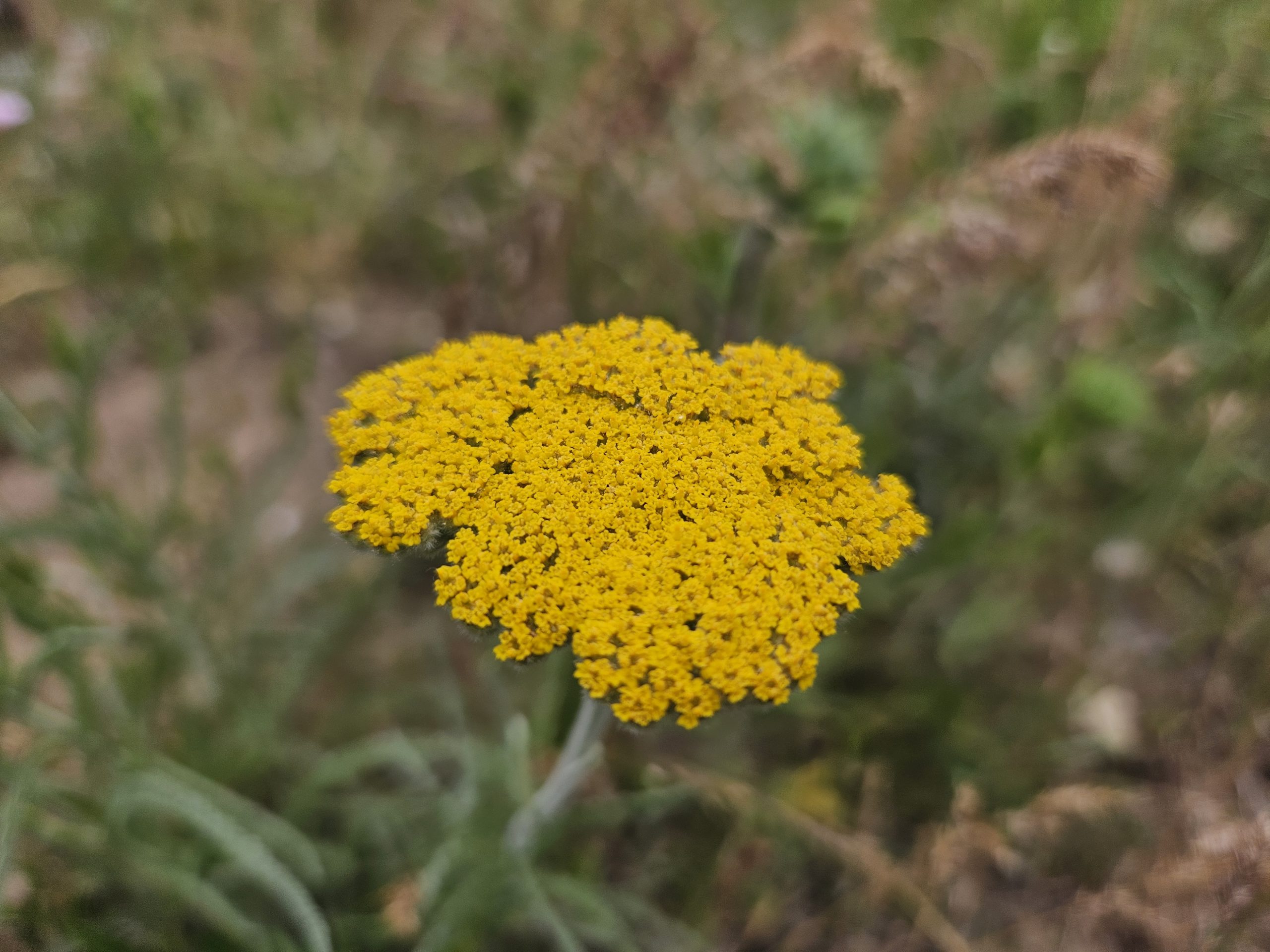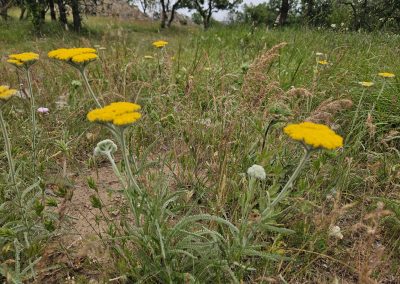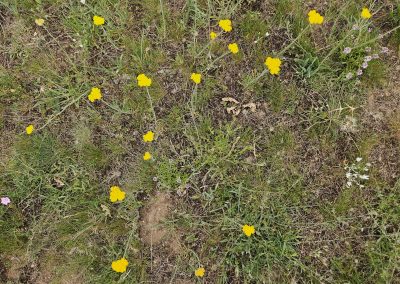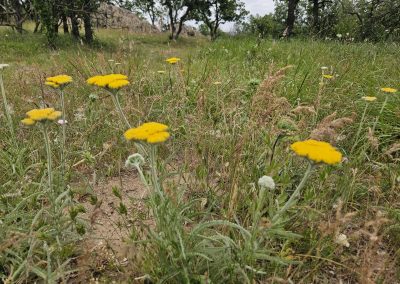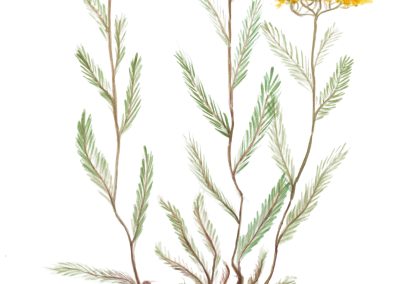Achillea Clypeolata
Scientific description
Scientific description
Taxon: Angiospermatophyta (Magnoliophyta)
Class: Dicotyledonatae (Magnoliatae)
Subclass: Asteridae
Order: Asterales (Compositales)
Family: Asteraceae (Compositae)
Common name: Yellow Yarrow.
Origin: Balkan.
Description: A 10–50 cm tall herbaceous plant with roots extending deep into the ground, with thick, woody rhizomes. Presenting one to five flowering stems and clusters of sterile leaf rosettes, the stem has fine hairs and is straight, striated, unbranched or rarely branched, erect, gradually leafless. The leaves also present fine hairs and are deeply divided, sessile, serrated. The flowers are small and radiate, lemon-yellow, arranged in small corymb inflorescences, which are further arranged in cymes. It blooms in June–July.
Propagation: seeds.
Ecology: It grows in meadows, shrubs, on uncultivated land. It thrives in dry, sunny areas, on neutral, xerophytic soils.
Use: In traditional medicine, the inflorescences are used in decoctions, infusions or teas to treat bronchitis, enterocolitis, gastritis, gastric colic, liver insufficiency, cystitis, anorexia, and some intestinal conditions. It can also treat hemorrhoids, menstrual pain, and pinworms.
Threat: It is a thermophilic, heliophilic, rare plant, mentioned in the Red List of superior plants from Romania (Oltean et al., 1994). It is threatened by the replacement of grasslands with arable and grazing land.
Descriere științifică
Încrengătura: Angiospermatophyta (Magnoliophyta)
Clasa: Dicotyledonatae (Magnoliatae)
Subclasa: Asteridae
Ordinul: Asterales (Compositales)
Familia: Asteraceae (Compositae)
Denumire populară: coada șoricelului galbenă.
Originea: balcanică.
Descrierea: este o plantă ierboasă, înaltă de 10–50 cm. Rădăcinile care pătrund adânc în sol, rizom gros, lemnos cu una-cinci tulpini florifere și fascicule sterile de frunze. Tulpina este puțin păroasă, dreaptă, striată, neramificată sau rar ramificată, erectă, descrescent foliată. Frunzele sunt puțin păroase, adânc divizate, sesile, serate. Florile sunt mici, radiare, de culoare galbenă ca lămâia, dispuse în inflorescențe calatidii mici, dispuse la rândul lor în corimb. Înflorește în lunile iunie–iulie.
Înmulțire: semințe.
Ecologie: crește prin pajiști, tufărișuri, pe terenuri necultivate. Este o plantă care vegetează foarte bine în zonele însorite și foarte uscate, pe soluri neutre, xerofite.
Utilizare: este o plantă care se utilizează în medicina tradițională, de la care se folosesc inflorescențele. Se folosește sub forma decocturilor, infuziilor, ceaiuri, pentru a trata bronșite, enterocolite, gastrite, colici gastrice, insuficiență hepatică, cistite, anorexie și anumite afecțiuni intestinale. Poate trata și hemoroizii, durerile menstruale și oxiuri.
Pericol: este o plantă termofilă, heliofilă, rară, menționată în Lista roșie a plantelor superioare din România (Oltean și colab., 1994). Este amenințată de înlocuirea pajiștilor cu terenuri arabile și de pășunat.
Επιστημονική περιγραφή
Συνομοταξία: Magnoliophyta
Κλάση: Δικοτυλήδονα (Magnoliatae)
Υποκατηγορία: Asteridae
Τάξη: Asterales (Compositales)
Οικογένεια: Asteraceae (Compositae)
Κοινή ονομασία: Κίτρινη αχιλλέα.
Προέλευση: Βαλκάνια.
Περιγραφή: Ένα ποώδες φυτό ύψους 10–50 cm με ρίζες που εκτείνονται βαθιά στο έδαφος, με παχιά, ξυλώδη ριζώματα. Παρουσιάζει ένα έως πέντε ανθοφόρα στελέχη και συστάδες από στείρους ρόδακες φύλλων· το στέλεχος έχει λεπτές τρίχες και είναι ευθύγραμμο, ραβδωτό, μη διακλαδισμένο ή σπάνια διακλαδισμένο, όρθιο, σταδιακά άφυλλο. Τα φύλλα έχουν επίσης λεπτές τρίχες και είναι βαθιά διαιρεμένα, άμισχα, οδοντωτά. Τα άνθη είναι μικρά και ακτινωτά, λεμονοκίτρινα, διατεταγμένα σε μικρές ταξιανθίες κορύμβου, που οργανώνονται περαιτέρω σε κύμες. Ανθίζει τον Ιούνιο–Ιούλιο.
Πολλαπλασιασμός: σπόροι.
Οικολογία: Αναπτύσσεται σε λιβάδια, θαμνώνες και ακαλλιέργητες εκτάσεις. Ευδοκιμεί σε ξηρές, ηλιόλουστες περιοχές, σε ουδέτερα, ξηροφυτικά εδάφη.
Χρήση: Στην παραδοσιακή ιατρική, οι ταξιανθίες χρησιμοποιούνται σε αφέψημα, εγχύματα ή τσάγια για τη θεραπεία της βρογχίτιδας, της εντεροκολίτιδας, της γαστρίτιδας, του γαστρικού κολικού, της ηπατικής ανεπάρκειας, της κυστίτιδας, της ανορεξίας και ορισμένων εντερικών παθήσεων. Μπορεί επίσης να βοηθήσει σε αιμορροΐδες, πόνους περιόδου και οξυούρους.
Απειλή: Θερμόφιλο, ηλιόφιλο και σπάνιο φυτό, αναφερόμενο στον Κόκκινο Κατάλογο ανώτερων φυτών της Ρουμανίας (Oltean et al., 1994). Απειλείται από την αντικατάσταση των λιβαδιών με αρόσιμες και βοσκήσιμες εκτάσεις.
Description scientifique
Taxon : Angiospermatophyta (Magnoliophyta)
Classe : Dicotyledonatae (Magnoliatae)
Sous-classe : Asteridae
Ordre : Asterales (Compositales)
Famille : Asteraceae (Compositae)
Nom commun : Achillée jaune
Origine : Balkans.
Description
L’Achillea clypeolata est une plante herbacée mesurant entre 10 et 50 cm de hauteur. Ses racines s’enfoncent profondément dans le sol et sont dotées de rhizomes épais et ligneux. Elle présente de un à cinq tiges florifères ainsi que des rosettes de feuilles stériles.
La tige est droite, striée, non ramifiée ou rarement ramifiée, dressée et progressivement dépourvue de feuilles. Elle est recouverte de fins poils. Les feuilles, également recouvertes de poils fins, sont profondément découpées, sessiles et dentées.
Les fleurs sont petites et rayonnantes, de couleur jaune citron. Elles sont disposées en petites inflorescences en corymbe, elles-mêmes regroupées en cymes. La floraison a lieu en juin–juillet.
Multiplication
La reproduction s’effectue par graines.
Écologie
L’Achillea clypeolata pousse dans les prairies, les arbustes et les terres non cultivées. Elle prospère dans les zones sèches et ensoleillées, sur des sols neutres et xérophytiques.
Utilisation
En médecine traditionnelle, ses inflorescences sont utilisées sous forme de décoctions, d’infusions ou de tisanes pour traiter la bronchite, l’entérocolite, la gastrite, les coliques gastriques, l’insuffisance hépatique, la cystite, l’anorexie et certaines affections intestinales. Elle est également utilisée pour soulager les hémorroïdes, les douleurs menstruelles et les oxyures.
Menaces
Plante thermophile et héliophile, elle est rare et figure sur la Liste rouge des plantes supérieures de Roumanie. Son habitat est menacé par la conversion des prairies en terres arables et en pâturages.
Creative writing inspired by Achillea Clypeolata
Written by Mara Parfinov
The Yellow Yarrow
Once upon a time, in a distant kingdom, love did not exist. Among people, there was only hatred and harsh words. However, one day, a little boy, wandering near his home, found a strange yellow and delicate plant on a field. When he saw it, the boy wanted to take it home, so he picked it, not knowing that it would not survive once removed from the soil.
He took it home and placed it in a glass of water. When his mother saw the colorful flower, she grabbed it and threw it away, unwilling to have anything bright in the house, as neither she nor the people around her had a bright heart. What she didn’t know, however, was that the flower was magical. She left the glass of water on the table and walked away. When the boy came home, he didn’t know where the flower had gone, but he did not suspect that the glass of water was the very one in which the flower had been. So, he took a sip. At that moment, he felt a tingling on his skin and shivers running through his body. Within three seconds, his body felt light. For the first time, he experienced emotions—he felt… happy.
Then, he realized this was the effect of the flower. And as he felt love and happiness, he thought that maybe others should feel the same. But where was the flower? He didn’t stop to look for it. Instead, he hurried outside and picked another one, which he then placed in multiple glasses of water. He went to his family first. He gave the water to his mother, father, grandparents, and sister, and the flower had the same effect on all of them. Together, they prepared more glasses of water infused with the flower and offered them to the villagers. They drank. Soon, the entire kingdom was filled with happiness, and love blossomed in everyone’s hearts.
From that day on, whenever a baby was born, they were given this special water so they would grow up to be kind. They even gave the flower a name: The Yarrow. A unique name, chosen by the very child who had discovered it. Years passed, and the kingdom was forever changed. People who once knew nothing of love learned to be gentle and kind to one another. There was no longer a need for magical flowers, for their hearts now carried warmth and goodness. The boy who had found the flower grew up. One day, as he walked through the same field where he had discovered it, he noticed that it no longer shone as brightly. The Yellow Yarrow had fulfilled its purpose—it had given love to an entire kingdom.
At that moment, the boy understood: the magic had never been in the flower alone, but in the power of sharing kindness. He placed his hand over his heart and smiled. From that day forward, love no longer needed a flower to exist—it lived in every person who had learned to give and receive it.
Coada Șoricelului
A fost odată un regat îndepărtat, unde nu exista iubire. Între oameni existau doar ura și cuvinte urâte. Însă, într-o zi, un băiețel care se plimba aproape de casa lui a găsit o plantă galbenă și gingașă pe un câmp. Când a văzut-o, a vrut să o ducă acasă și a rupt-o, neștiind că aceasta nu va mai trăi dacă este scoasă din pământ.
A pus-o într-un pahar cu apă. Mama, văzând floarea colorată, a aruncat-o, nevrând să aibă lucruri luminoase în casă, căci nici ea, nici cei din jur nu aveau suflet luminos. Ce nu știa, însă, era că floarea era magică. A lăsat paharul cu apă pe masă și a plecat. Când băiatul a venit acasă, nu știa unde era floarea, dar nu a bănuit că paharul cu apă era cel în care stătuse. A băut o înghițitură și a simțit furnicături și fiori în tot corpul. În trei secunde, corpul i s-a simțit ușor. Pentru prima dată, simțea emoții—era fericit.
Și-a dat seama că acesta era efectul florii și s-a gândit că și alții ar trebui să simtă la fel. Nu a căutat floarea, ci a ieșit să culeagă alta, pe care a pus-o în mai multe pahare cu apă. Le-a dat mamei, tatei, bunicilor și surorii, iar efectul a fost același. Împreună au pregătit mai multe pahare cu apă și flori și le-au oferit sătenilor. Toată lumea era fericită și plină de iubire.
De atunci, când se năștea un copil, i se dădea să bea din acea apă pentru a crește bun. I-au dat florii un nume: Coada Șoricelului—ales chiar de băiatul care o descoperise. Anii au trecut, iar regatul s-a schimbat pentru totdeauna. Oamenii au învățat să fie blânzi și buni. Nu mai aveau nevoie de flori magice, căci inimile lor păstrau acum căldura și bunătatea. Băiatul a crescut, iar într-o zi, trecând prin același câmp, a văzut că floarea nu mai strălucea la fel. Își împlinise menirea: dăruise iubire întregului regat.
Atunci a înțeles: magia nu fusese niciodată doar în floare, ci în puterea de a împărtăși bunătate. Și-a pus mâna pe inimă și a zâmbit. De atunci, iubirea nu mai avea nevoie de o floare pentru a exista—trăia în fiecare om care învățase să o dăruiască și să o primească.
Η Κίτρινη Αχιλλέα
Μια φορά κι έναν καιρό, σε ένα μακρινό βασίλειο, η αγάπη δεν υπήρχε. Υπήρχε μόνο μίσος και σκληρά λόγια. Μια μέρα, ένα μικρό αγόρι βρήκε σε ένα χωράφι ένα κίτρινο και ευαίσθητο φυτό. Το πήρε σπίτι, μη γνωρίζοντας ότι δεν θα επιβίωνε εκτός εδάφους.
Το έβαλε σε ένα ποτήρι με νερό. Η μητέρα του, βλέποντας το πολύχρωμο λουλούδι, το πέταξε, χωρίς να ξέρει ότι ήταν μαγικό. Το ποτήρι έμεινε στο τραπέζι. Ο μικρός ήπιε μια γουλιά και ένιωσε μούδιασμα και ρίγη. Μέσα σε τρία δευτερόλεπτα, ένιωσε ευτυχία για πρώτη φορά.
Κατάλαβε ότι ήταν η επίδραση του λουλουδιού και σκέφτηκε να το μοιραστεί με άλλους. Μάζεψε κι άλλα λουλούδια, τα έβαλε σε ποτήρια με νερό και τα έδωσε στην οικογένειά του και στους χωρικούς. Όλοι ένιωσαν αγάπη και χαρά.
Από τότε, κάθε νεογέννητο έπινε αυτό το ειδικό νερό. Το λουλούδι ονομάστηκε Αχιλλέα από το ίδιο το παιδί. Τα χρόνια πέρασαν και το βασίλειο άλλαξε για πάντα. Δεν υπήρχε πια ανάγκη για μαγικά λουλούδια, γιατί οι καρδιές ήταν πλέον γεμάτες καλοσύνη. Όταν το αγόρι μεγάλωσε, είδε ότι η Κίτρινη Αχιλλέα δεν έλαμπε πια τόσο· είχε εκπληρώσει τον σκοπό της.
Κατάλαβε ότι η μαγεία ήταν στην πράξη της καλοσύνης. Έβαλε το χέρι στην καρδιά του και χαμογέλασε. Από τότε, η αγάπη ζούσε σε κάθε άνθρωπο που είχε μάθει να τη δίνει και να τη λαμβάνει.
L'achillée jaune
Il était une fois, dans un royaume lointain, l'amour n'existait pas. Il n'y avait que haine et paroles dures. Un jour, un petit garçon trouva dans un champ une plante jaune et délicate. Il la cueillit sans savoir qu'elle ne survivrait pas hors de terre.
Il la plaça dans un verre d'eau. Sa mère, voyant la fleur colorée, la jeta, ignorant qu'elle était magique. Le verre resta sur la table. Le garçon en but une gorgée et ressentit des picotements et des frissons. En trois secondes, il se sentit heureux pour la première fois.
Il comprit que c'était l'effet de la fleur et voulut le partager. Il cueillit d'autres fleurs, les mit dans plusieurs verres d'eau et les donna à sa famille et aux villageois. Tous ressentirent amour et bonheur.
Dès lors, chaque bébé recevait cette eau spéciale. La fleur fut nommée « achillée » par l'enfant qui l'avait découverte. Les années passèrent et le royaume changea à jamais. Plus besoin de fleurs magiques : les cœurs étaient emplis de chaleur. Devenu adulte, l'enfant vit un jour que l'achillée ne brillait plus autant : elle avait accompli sa mission.
Il comprit que la magie résidait dans le partage de la bonté. La main sur le cœur, il sourit. L'amour vivait désormais dans chaque personne qui avait appris à le donner et à le recevoir.


